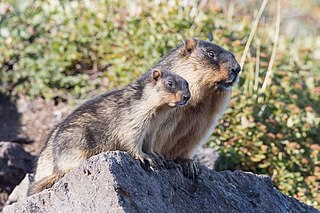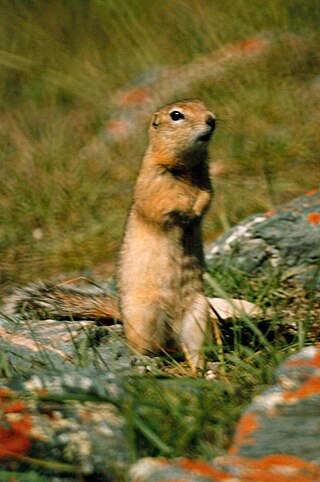
The groundhog, also known as the woodchuck, is a rodent of the family Sciuridae, belonging to the group of large ground squirrels known as marmots. The groundhog is a lowland creature of North America; it is found through much of the Eastern United States, across Canada and into Alaska. It was first scientifically described by Carl Linnaeus in 1758.

Marmots are large ground squirrels in the genus Marmota, with 15 species living in Asia, Europe, and North America. These herbivores are active during the summer, when they can often be found in groups, but are not seen during the winter, when they hibernate underground. They are the heaviest members of the squirrel family.

The hoary marmot is a species of marmot that inhabits the mountains of northwest North America. Hoary marmots live near the tree line on slopes with grasses and forbs to eat and rocky areas for cover.

The Vancouver Island marmot naturally occurs only in the high mountains of Vancouver Island, in British Columbia. This particular marmot species is large compared to some other marmots, and most other rodents. Marmots are the largest members of the Sciuridae family, with weights of adults varying from 3 to 7 kg depending on age and time of year.

The yellow-bellied marmot, also known as the rock chuck, is a large, stout-bodied ground squirrel in the marmot genus. It is one of fourteen species of marmots, and is native to mountainous and semi-arid regions of southwestern Canada and western United States, including the Rocky Mountains, Sierra Nevada, and the Great Basin, often living above 2,000 metres. The fur is mainly brown, with a dark bushy tail, yellow chest and white patch between the eyes, and they weigh up to approximately 5 kilograms. They live in burrows in colonies of up to twenty individuals with a single dominant male. They are diurnal and feed on plant material, insects, and bird eggs. They hibernate for approximately eight months starting in September and lasting through the winter.

The alpine marmot is a large ground-dwelling squirrel, from the genus of marmots. It is found in high numbers in mountainous areas of central and southern Europe, at heights between 800 and 3,200 m (2,600–10,500 ft) in the Alps, Carpathians, Tatras and Northern Apennines. In 1948 they were reintroduced with success in the Pyrenees, where the alpine marmot had disappeared at end of the Pleistocene epoch.

The Olympic marmot is a rodent in the squirrel family, Sciuridae; it occurs only in the U.S. state of Washington, on the middle elevations of the Olympic Peninsula. The closest relatives of this species are the hoary marmot and the Vancouver Island marmot. In 2009, it was declared the official endemic mammal of Washington.

The Himalayan marmot is a marmot species that inhabits alpine grasslands throughout the Himalayas and on the Tibetan Plateau. It is IUCN Red Listed as Least Concern because of its wide range and possibly large population.

The bobak marmot, also known as the steppe marmot, is a species of marmot that inhabits the steppes of Eastern Europe and Central Asia. It is a social animal and inhabits steppe grassland, including cultivated field borders. It hibernates for more than half the year. Litter sizes average about five offspring and it takes three years for the young marmots to reach sexual maturity. Male offspring leave the home colony after their second winter, and about 60% of mature females give birth in any one year.

The Mongolian-Manchurian grassland, also known as the Mongolian-Manchurian steppe or Gobi-Manchurian steppe, in the temperate grassland biome, is an ecoregion in East Asia covering parts of Mongolia, the Chinese Autonomous region of Inner Mongolia, and Northeast China.

The long-tailed marmot or golden marmot is a marmot species in the family Sciuridae. It occurs in mountainous regions in the central parts of Asia where it lives in open or lightly wooded habitats, often among rocks where dwarf junipers grow. It is IUCN Red Listed as Least Concern. As suggested by its name, it is a relatively long-tailed species of marmot.

The Alaska marmot, also known as the Brooks Range marmot or the Brower's marmot, is a species of rodent in the family Sciuridae. Once considered to be the same species as the hoary marmot, it is now known to be unique. Alaska marmots are found in the scree slopes of the Brooks Range, Alaska. Specifically, they prefer to dwell on rocky, mountainous terrain, generally near lakes. They eat vegetation found on mountainsides, such as grasses, seeds, and lichen. Their relatively thick bodies are covered in dense, grey fur. They live in large colonies that consist of multiple families. During the winter, they hibernate for long periods of time in burrows. While not well researched, they are not believed to be particularly threatened, by human activity or otherwise. The Alaskan government has designated February 2 as "Marmot Day," a holiday intended to recognize the prevalence of marmots in the state, similar to the more widely celebrated American holiday of Groundhog Day.

The black-capped marmot is a species of rodent in the family Sciuridae. It is endemic to the Russian Far East, but its range is discontinuous and divided into three main parts, each with its own subspecies. The black-capped marmot lives in arctic tundra and alpine habitats from near sea-level to an altitude of 2,000 m (6,600 ft). Depending on exact subpopulation, they hibernate for 6–8 months each year, which is long for a marmot.

The Menzbier's marmot is a species of rodent in the family Sciuridae from Central Asia. Its name commemorates Russian zoologist Mikhail Aleksandrovich Menzbier.

The tarbagan marmot is a species of rodent in the family Sciuridae. It is found in China, northern and western Mongolia, and Russia. In the Mongolian Altai Mountains, its range overlaps with that of the Gray marmot. The species was classified as endangered by the IUCN in 2008.

The long-tailed ground squirrel or Eversmann's souslik is a species of rodent in the squirrel family Sciuridae. It is found in China, Kazakhstan, Mongolia, and Russia.
Spermophilus brevicauda is a species of rodent in the family Sciuridae. It is found in eastern Kazakhstan and the northern half of the Xinjiang region of China.
The forest-steppe marmot is a rodent species of the marmot genus found in south-central Russia. It lives in wooded forest steppe at an altitude of 180–450 m (590–1,480 ft) in a relatively small region located directly east of the upper Ob River. It has traditionally been considered a subspecies of the similar, more southerly distributed gray marmot, but was separated mainly due to different diploid numbers. Forest-steppe marmots have a head-and-body length of 45–66 cm (18–26 in), and light individuals weigh as little as 3 kg (6.6 lb) in the spring and heavy individuals as much as 8.9 kg (20 lb) in the autumn. It hibernates for about 61⁄2 months starting in August or September.

The Altai montane forest and forest steppe ecoregion covers patches of the subalpine forest belt on the Altai Mountains, crossing the border region where Russia, Kazakhstan, Mongolia and China meet. The region has high biodiversity, as it is located in transition zones between different ecoregions, altitudes, and climate zones. It is in the Palearctic realm, with a Cold semi-arid climate. It covers 35,199,998 km2 (13,590,795 sq mi).

The Sayan montane conifer forests ecoregion covers the mid-elevation levels of the Sayan Mountains, the high mountain range between the taiga of Siberia, Russia to the north, and the steppes of Mongolia to the south. The slopes of the mountains at the mid-altitudes are covered by Temperate coniferous forest. The ecoregion is in the Palearctic realm, with a cold semi-arid climate. It covers 35,741,835 km2 (13,800,000 sq mi).



















